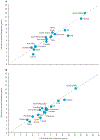Lifetime risk, life expectancy, and years of life lost to type 2 diabetes in 23 high-income jurisdictions: a multinational, population-based study
- PMID: 36183736
- PMCID: PMC10988609
- DOI: 10.1016/S2213-8587(22)00252-2
Lifetime risk, life expectancy, and years of life lost to type 2 diabetes in 23 high-income jurisdictions: a multinational, population-based study
Erratum in
-
Correction to Lancet Diabetes Endocrinol 2022; published online Sept 29. https://doi.org/10.1016/S2213-8587(22)00252-2.Lancet Diabetes Endocrinol. 2022 Nov;10(11):e11. doi: 10.1016/S2213-8587(22)00279-0. Epub 2022 Oct 10. Lancet Diabetes Endocrinol. 2022. PMID: 36228634 No abstract available.
Abstract
Background: Diabetes is a major public health issue. Because lifetime risk, life expectancy, and years of life lost are meaningful metrics for clinical decision making, we aimed to estimate these measures for type 2 diabetes in the high-income setting.
Methods: For this multinational, population-based study, we sourced data from 24 databases for 23 jurisdictions (either whole countries or regions of a country): Australia; Austria; Canada; Denmark; Finland; France; Germany; Hong Kong; Hungary; Israel; Italy; Japan; Latvia; Lithuania; the Netherlands; Norway; Scotland; Singapore; South Korea; Spain; Taiwan; the UK; and the USA. Our main outcomes were lifetime risk of type 2 diabetes, life expectancy in people with and without type 2 diabetes, and years of life lost to type 2 diabetes. We modelled the incidence and mortality of type 2 diabetes in people with and without type 2 diabetes in sex-stratified, age-adjusted, and calendar year-adjusted Poisson models for each jurisdiction. Using incidence and mortality, we constructed life tables for people of both sexes aged 20-100 years for each jurisdiction and at two timepoints 5 years apart in the period 2005-19 where possible. Life expectancy from a given age was computed as the area under the survival curves and lifetime lost was calculated as the difference between the expected lifetime of people with versus without type 2 diabetes at a given age. Lifetime risk was calculated as the proportion of each cohort who developed type 2 diabetes between the ages of 20 years and 100 years. We estimated 95% CIs using parametric bootstrapping.
Findings: Across all study cohorts from the 23 jurisdictions (total person-years 1 577 234 194), there were 5 119 585 incident cases of type 2 diabetes, 4 007 064 deaths in those with type 2 diabetes, and 11 854 043 deaths in those without type 2 diabetes. The lifetime risk of type 2 diabetes ranged from 16·3% (95% CI 15·6-17·0) for Scottish women to 59·6% (58·5-60·8) for Singaporean men. Lifetime risk declined with time in 11 of the 15 jurisdictions for which two timepoints were studied. Among people with type 2 diabetes, the highest life expectancies were found for both sexes in Japan in 2017-18, where life expectancy at age 20 years was 59·2 years (95% CI 59·2-59·3) for men and 64·1 years (64·0-64·2) for women. The lowest life expectancy at age 20 years with type 2 diabetes was observed in 2013-14 in Lithuania (43·7 years [42·7-44·6]) for men and in 2010-11 in Latvia (54·2 years [53·4-54·9]) for women. Life expectancy in people with type 2 diabetes increased with time for both sexes in all jurisdictions, except for Spain and Scotland. The life expectancy gap between those with and without type 2 diabetes declined substantially in Latvia from 2010-11 to 2015-16 and in the USA from 2009-10 to 2014-15. Years of life lost to type 2 diabetes ranged from 2·5 years (Latvia; 2015-16) to 12·9 years (Israel Clalit Health Services; 2015-16) for 20-year-old men and from 3·1 years (Finland; 2011-12) to 11·2 years (Israel Clalit Health Services; 2010-11 and 2015-16) for 20-year-old women. With time, the expected number of years of life lost to type 2 diabetes decreased in some jurisdictions and increased in others. The greatest decrease in years of life lost to type 2 diabetes occurred in the USA between 2009-10 and 2014-15 for 20-year-old men (a decrease of 2·7 years).
Interpretation: Despite declining lifetime risk and improvements in life expectancy for those with type 2 diabetes in many high-income jurisdictions, the burden of type 2 diabetes remains substantial. Public health strategies might benefit from tailored approaches to continue to improve health outcomes for people with diabetes.
Funding: US Centers for Disease Control and Prevention and Diabetes Australia.
Copyright © 2022 Elsevier Ltd. All rights reserved.
Conflict of interest statement
Declaration of interests SKP is currently a full-time employee of AstraZeneca. All other authors declare no competing interests.
Figures


Comment in
-
New metrics to support diabetes education and advocacy.Lancet Diabetes Endocrinol. 2022 Nov;10(11):765-766. doi: 10.1016/S2213-8587(22)00271-6. Epub 2022 Sep 29. Lancet Diabetes Endocrinol. 2022. PMID: 36183735 No abstract available.
References
-
- Gregg EW, Zhuo X, Cheng YJ, Albright AL, Narayan KMV, Thompson TJ. Trends in lifetime risk and years of life lost due to diabetes in the USA, 1985–2011: a modelling study. Lancet Diabetes Endocrinol 2014; 2: 867–74. - PubMed
-
- Magliano DJ, Shaw JE, Shortreed SM, et al. Lifetime risk and projected population prevalence of diabetes. Diabetologia 2008; 51: 2179–86. - PubMed
Publication types
MeSH terms
Grants and funding
LinkOut - more resources
Full Text Sources
Medical
Miscellaneous

